Quinta da Regaleira Symbolism: The Occult Mysteries of a Portuguese Palace and Garden
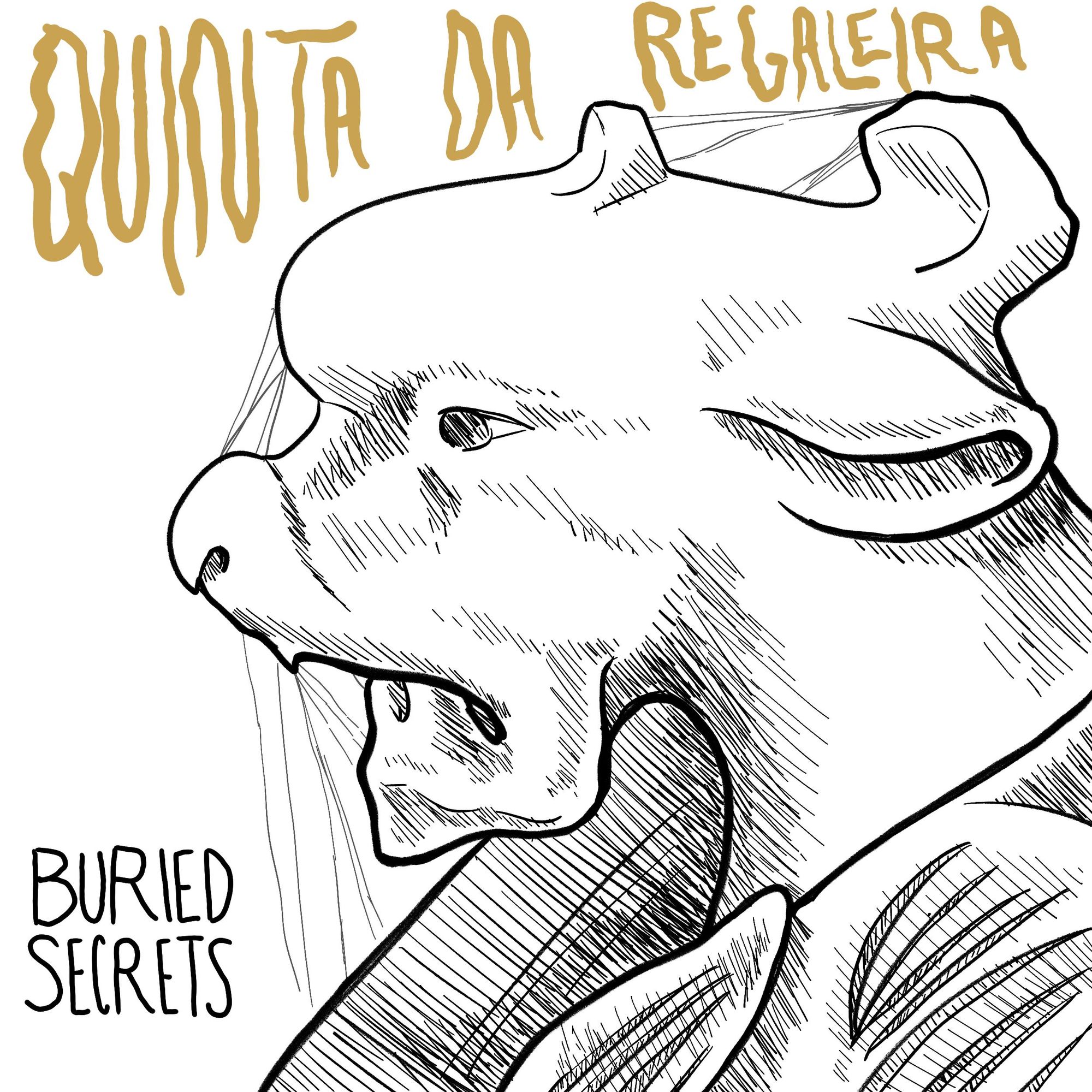
Quinta da Regaleira Symbolism: A deep dive into the mysteries and history of a strange palace and garden built by an eccentric millionaire in Sintra, Portugal.
Sometimes described as a playground for adults, Quinta da Regaleira is a mysterious estate built by a millionaire entomologist in the early 20th century, full of occult and masonic references. Chris talks about the history, symbolism, and some theories about the place.
Highlights include:
• A city named after a moon temple
• Freemason symbolism
• An Initiation Well
• A tree that’s the last of its kind
• Green men
• Pentagrams on church floors
• Secret tunnels
• A “floating” library
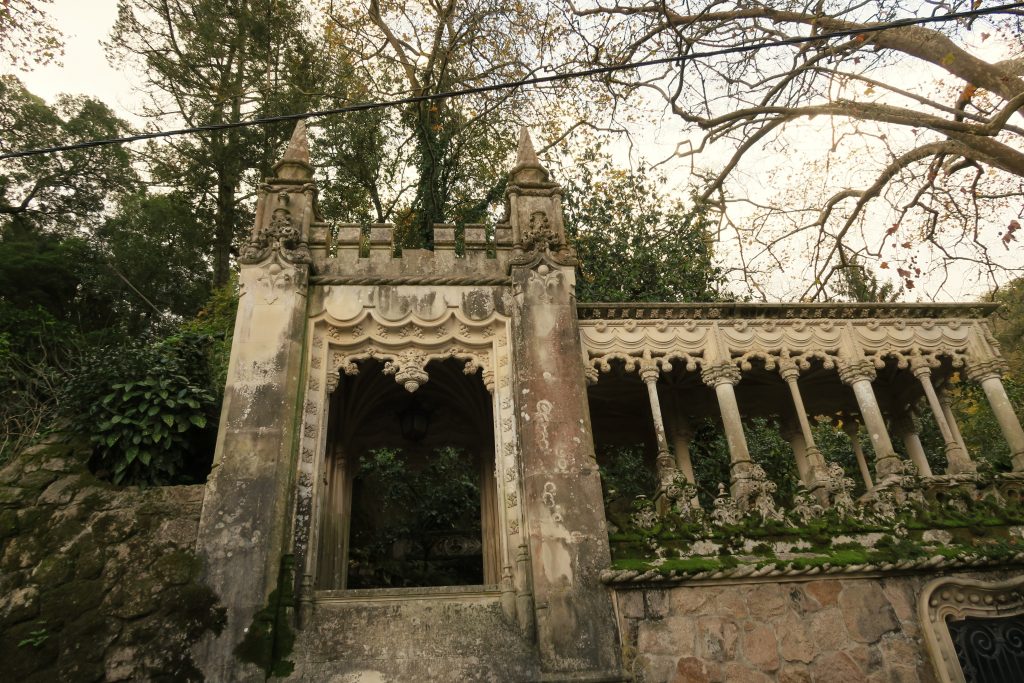
Photo by Chris
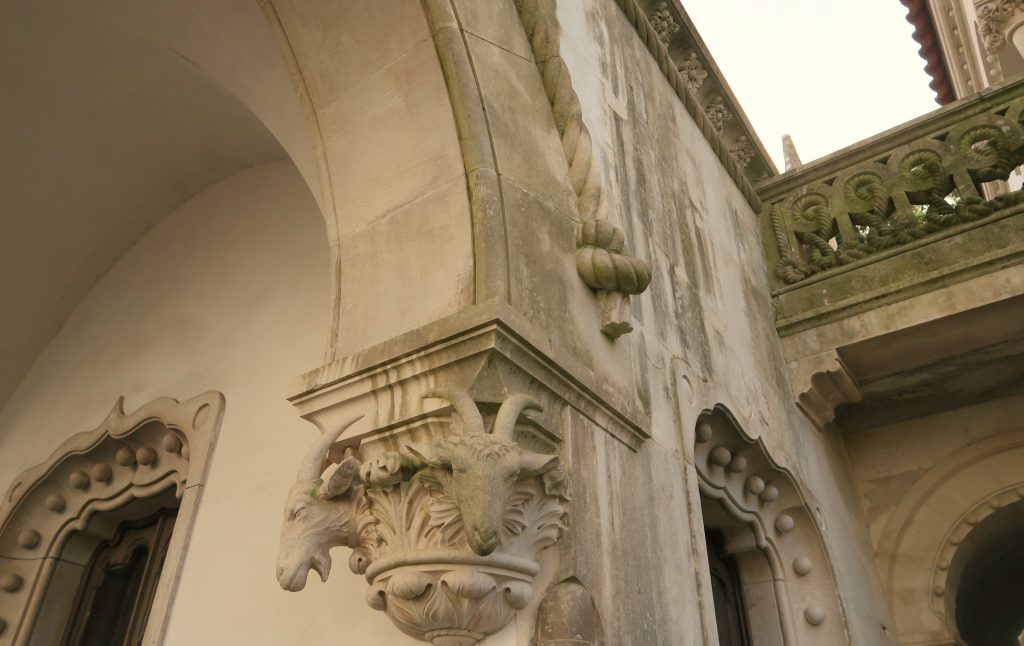
A goat head decorating a building / Photo by Chris
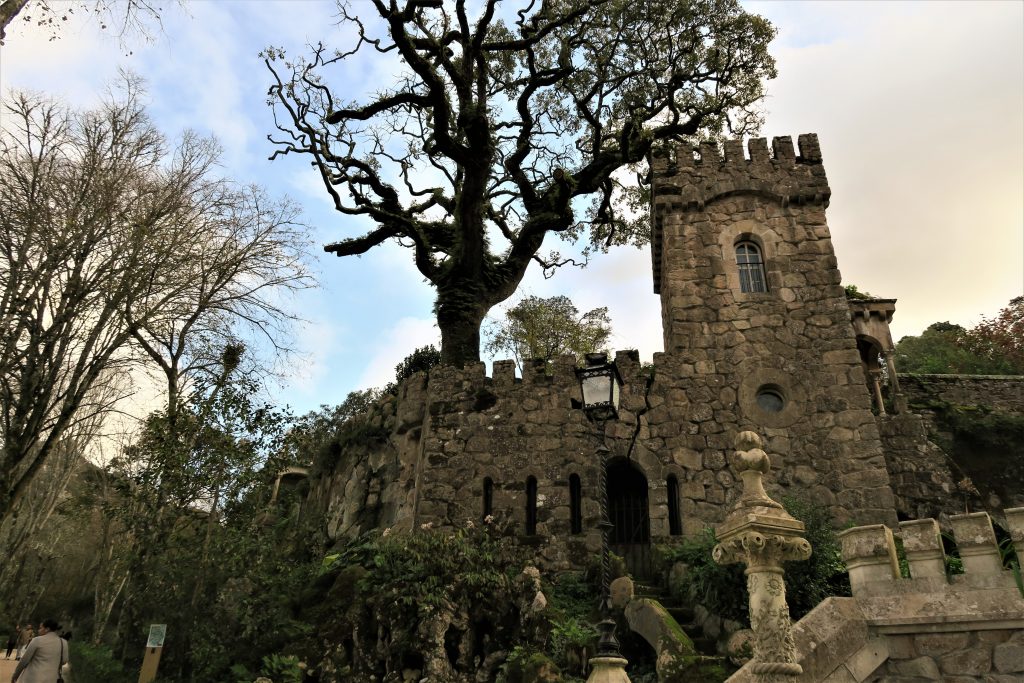
Photo by Chris
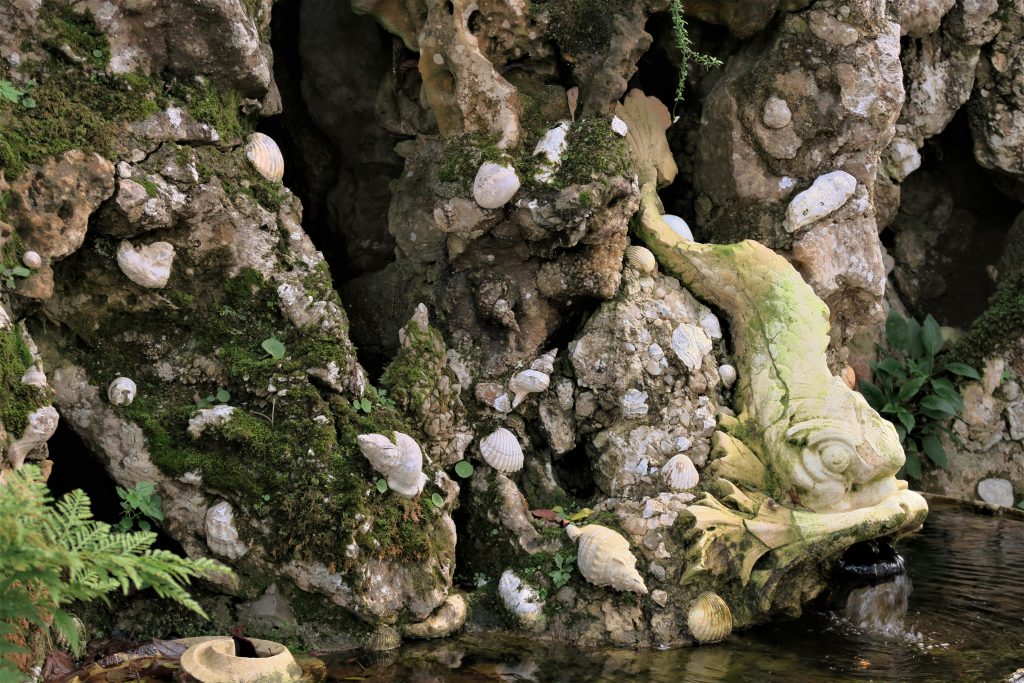
Photo by Chris
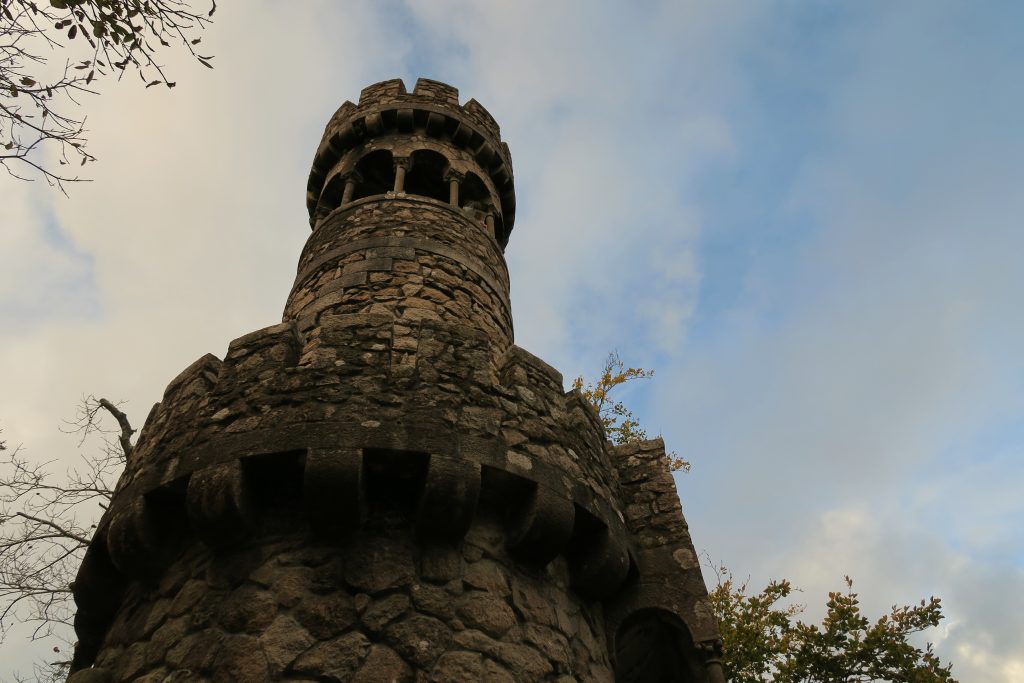
Tower / Photo by Chris
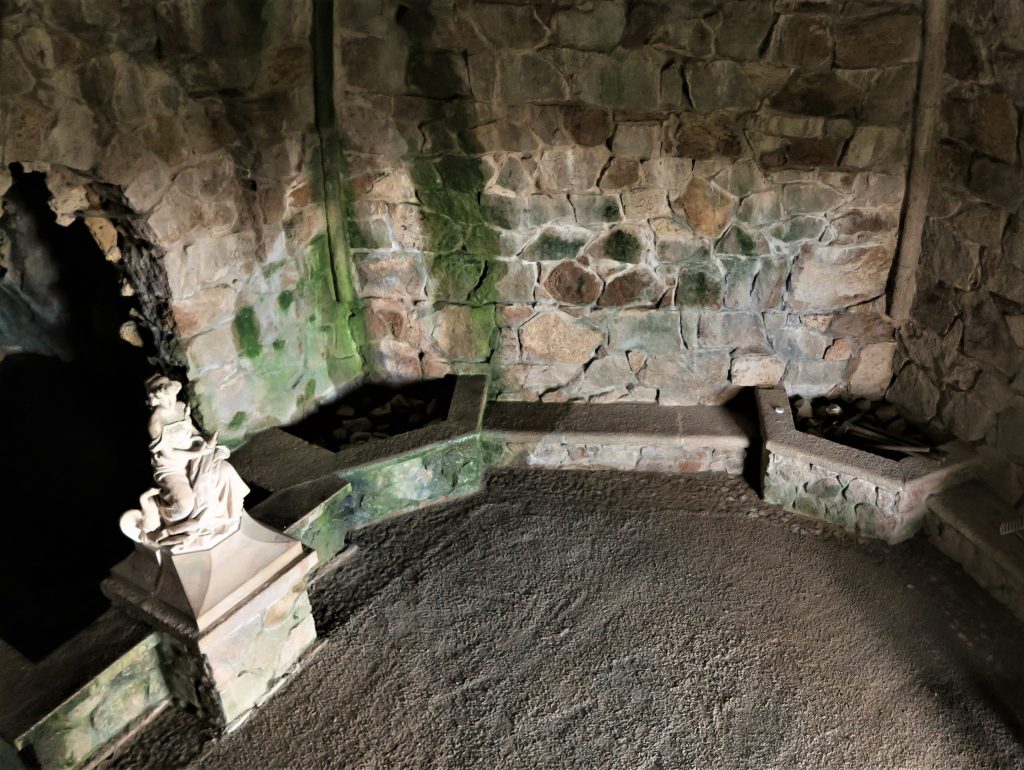
Leda’s Cave / Photo by Chris
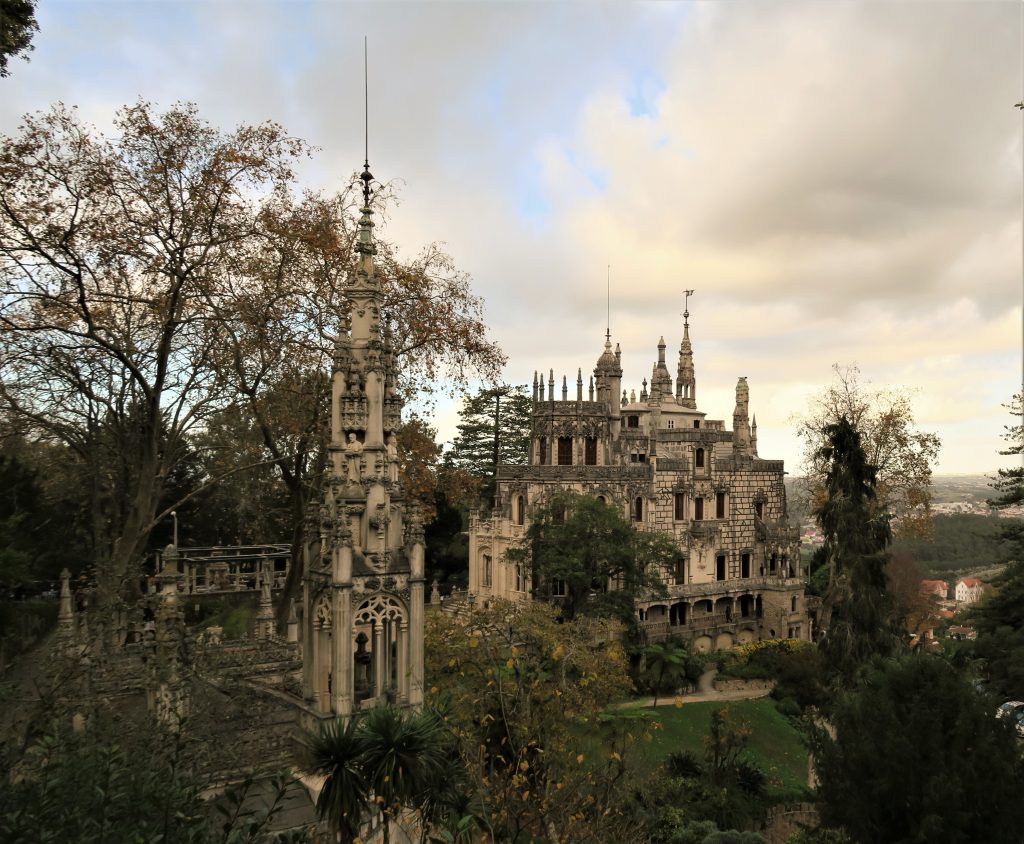
The palace / Photo by Chris
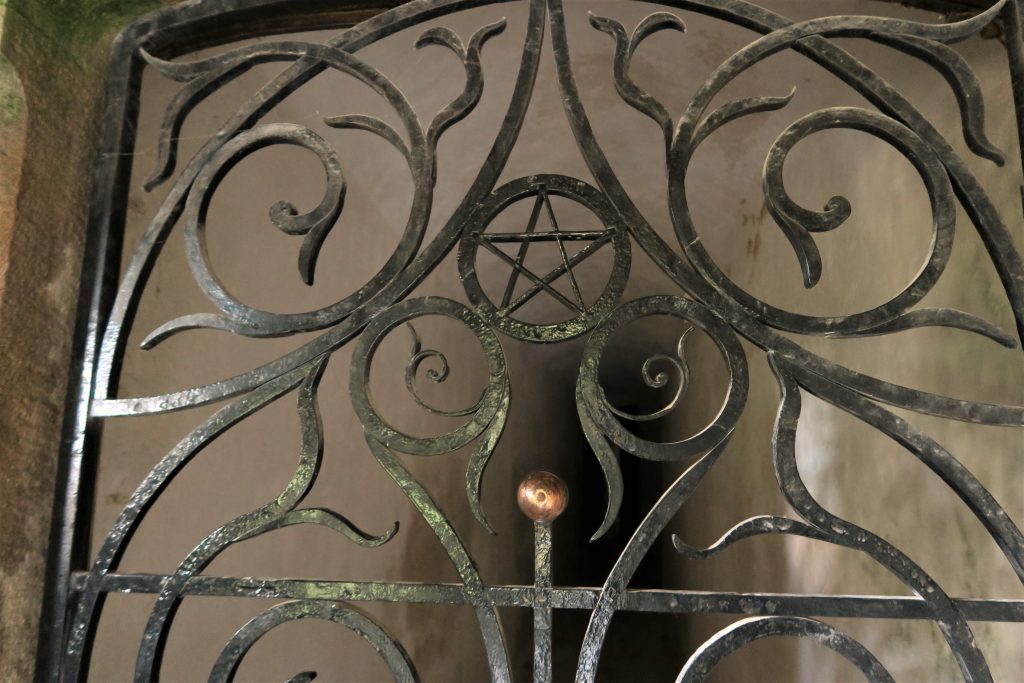
The door to the church basement / Photo by Chris
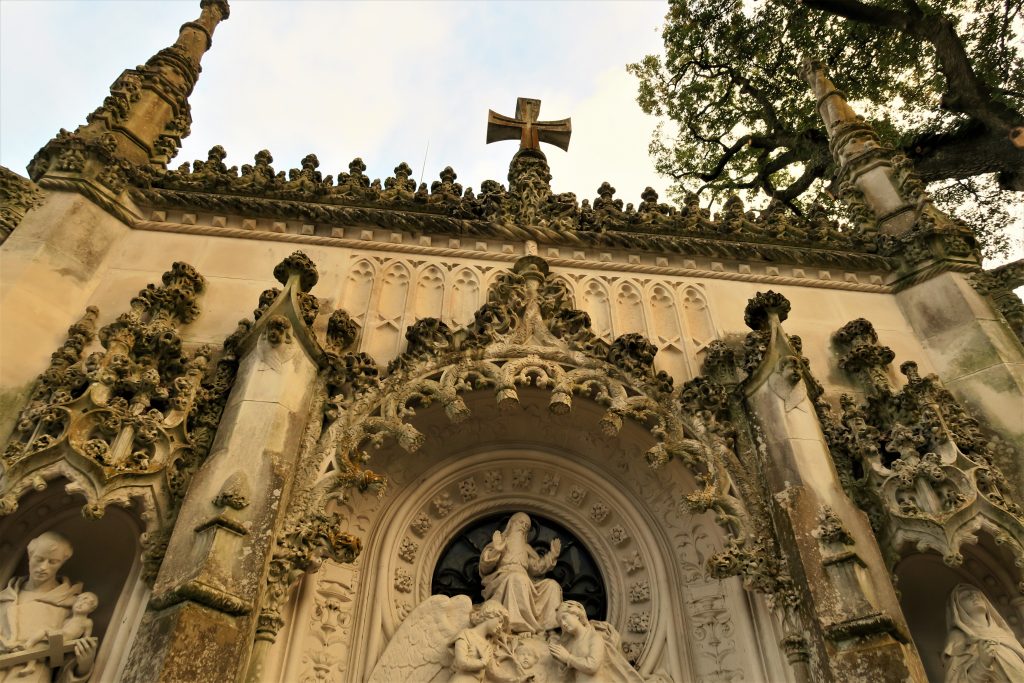
The front of the church / Photo by Chris
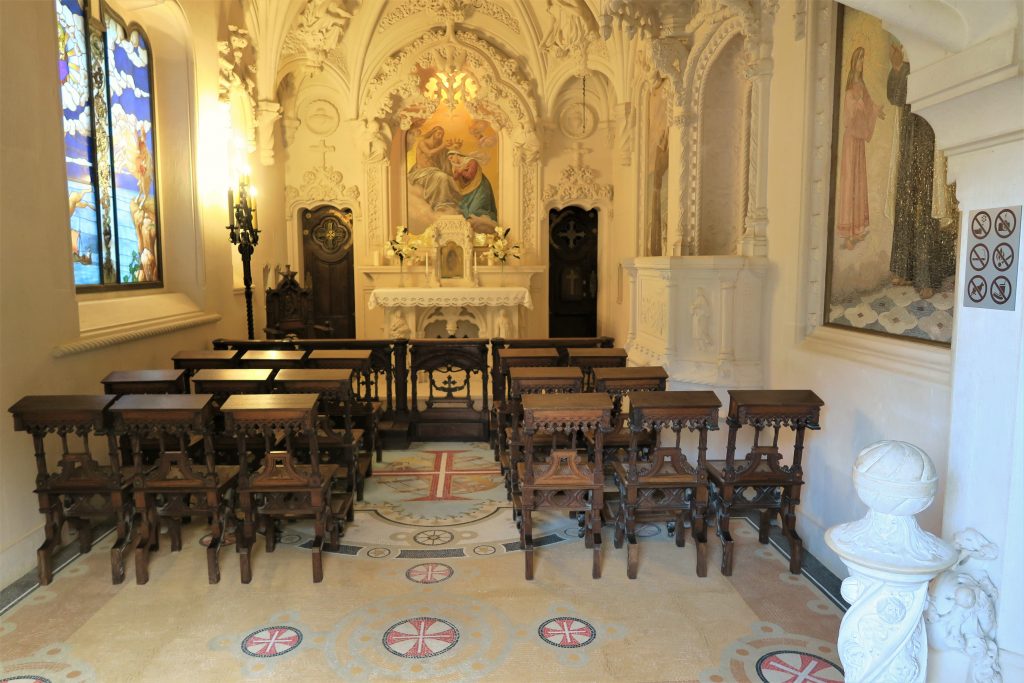
The church interior (ground floor) / Photo by Chris
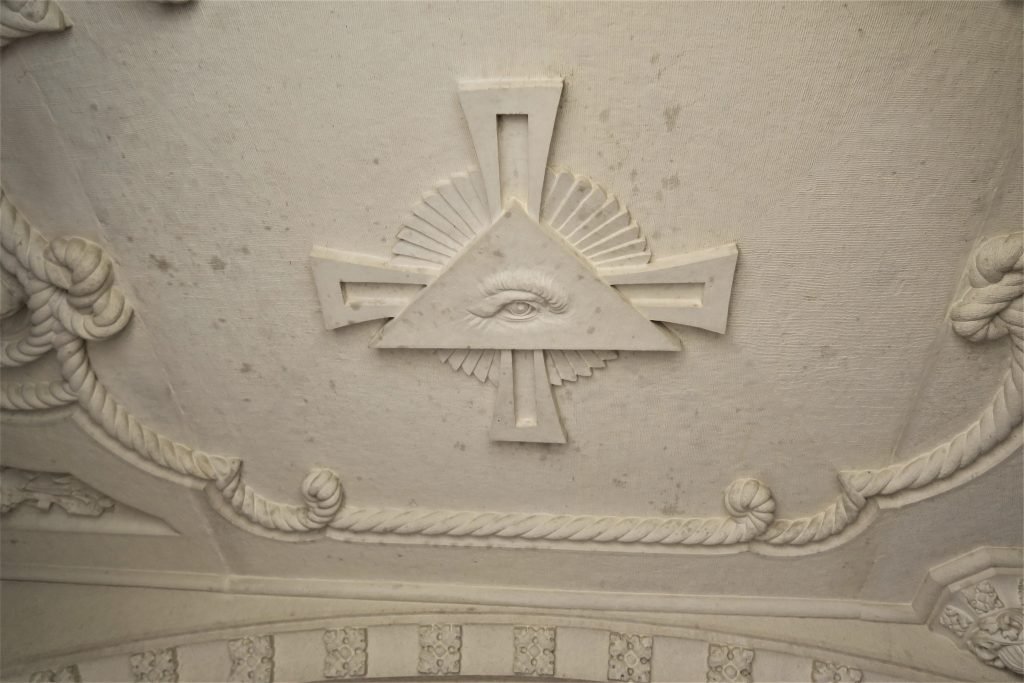
The church ceiling (ground floor) / Photo by Chris
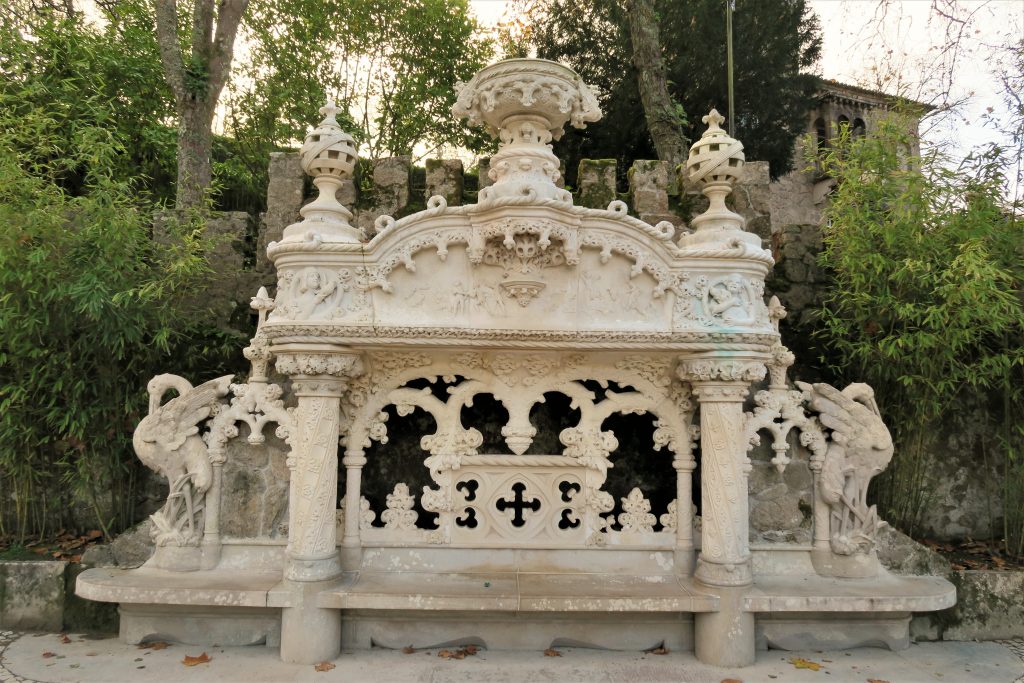
Photo by Chris
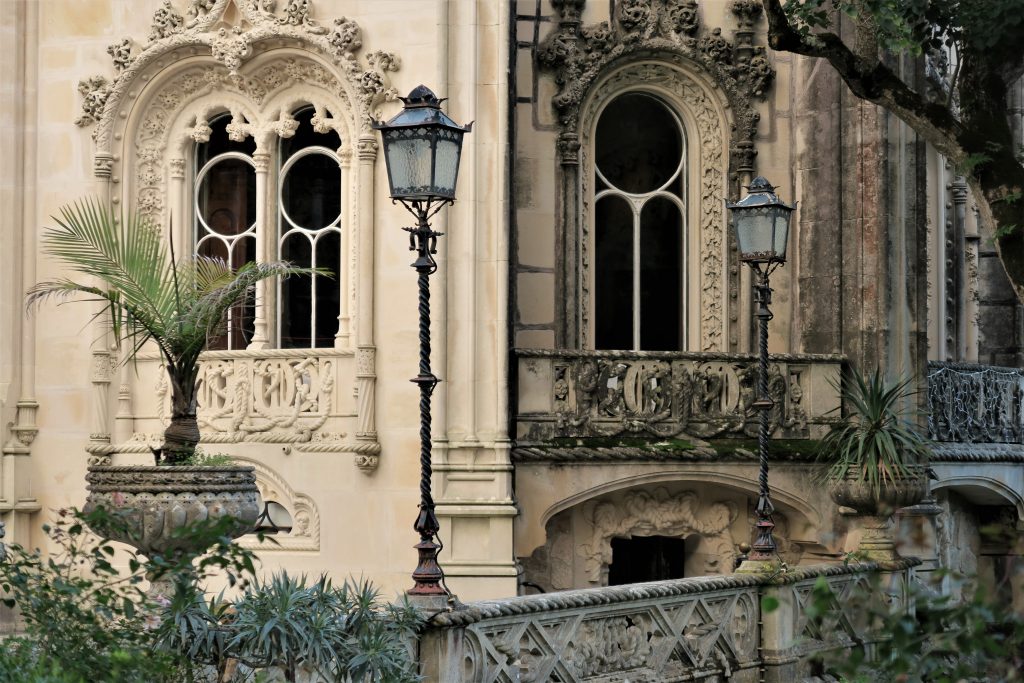
The palace / Photo by Chris
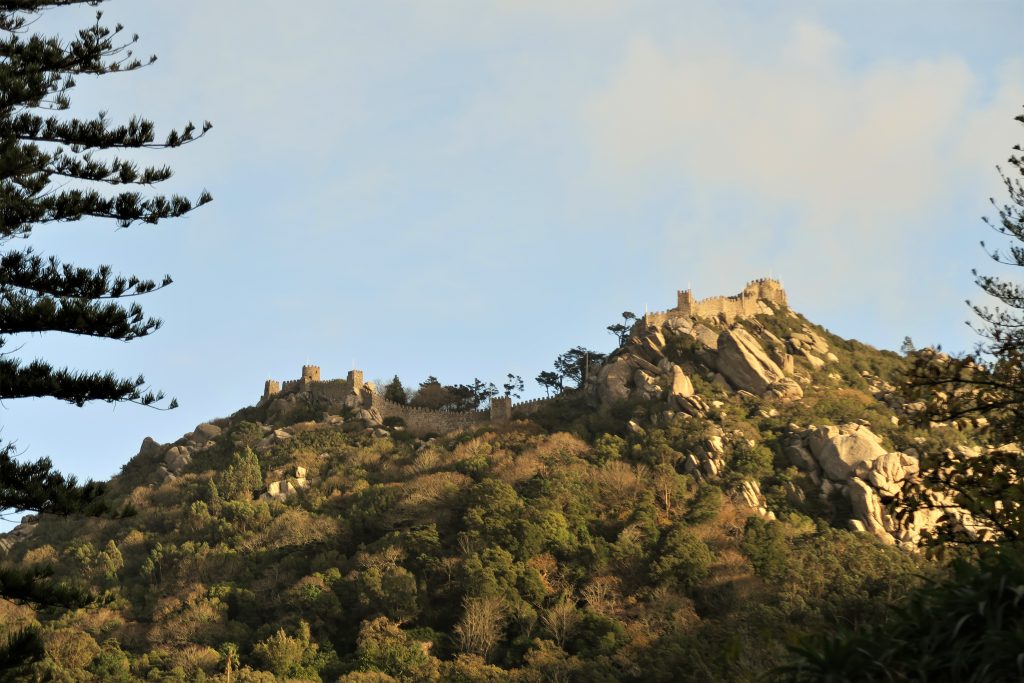
Another castle, seen from Quinta da Regaleira / Photo by Chris
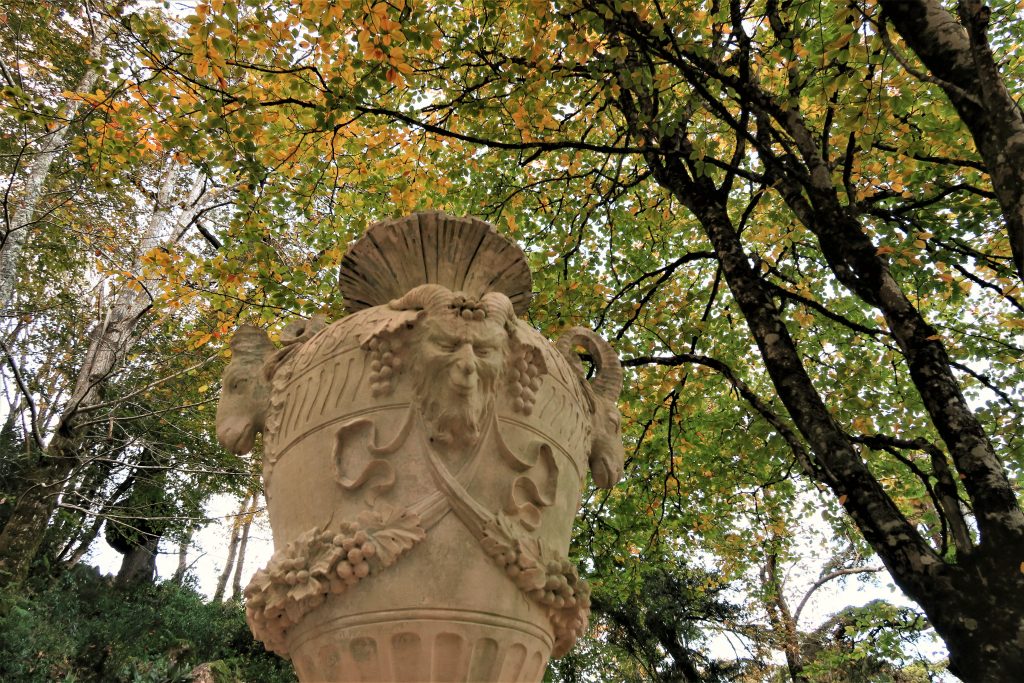
A green man adorns a decorative urn / Photo by Chris
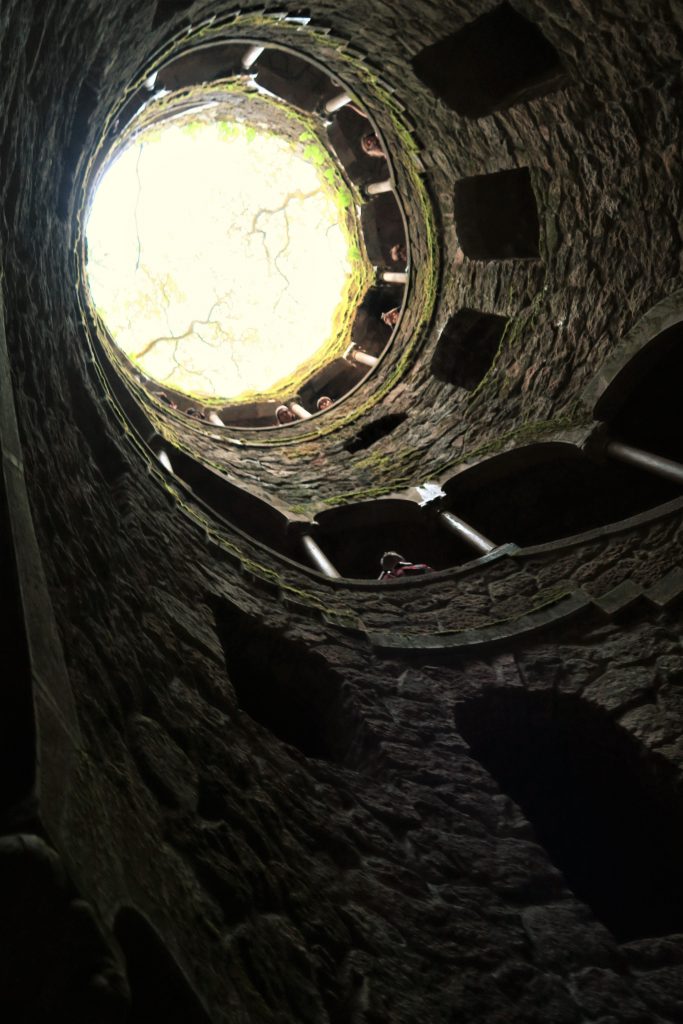
The Initiation Well / Photo by Chris
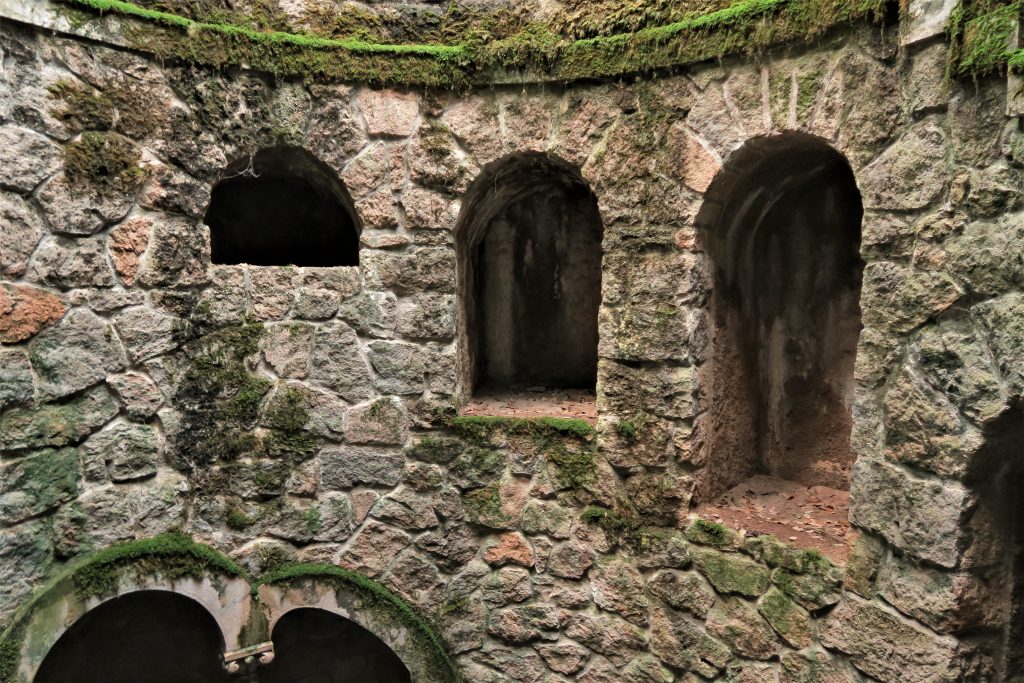
The Initiation Well / Photo by Chris
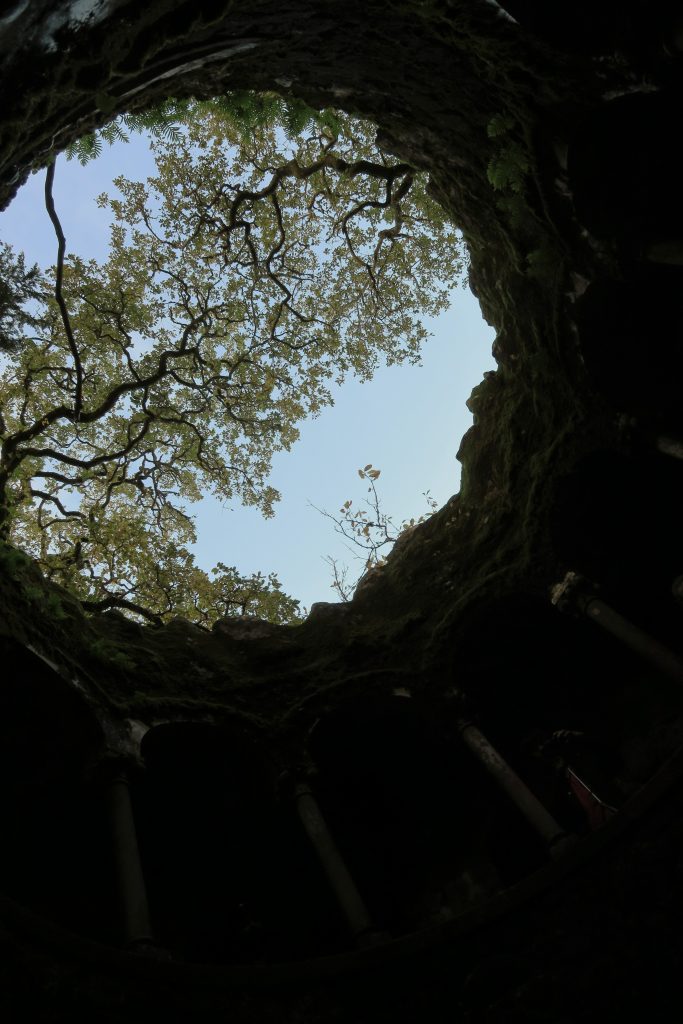
The Initiation Well / Photo by Chris
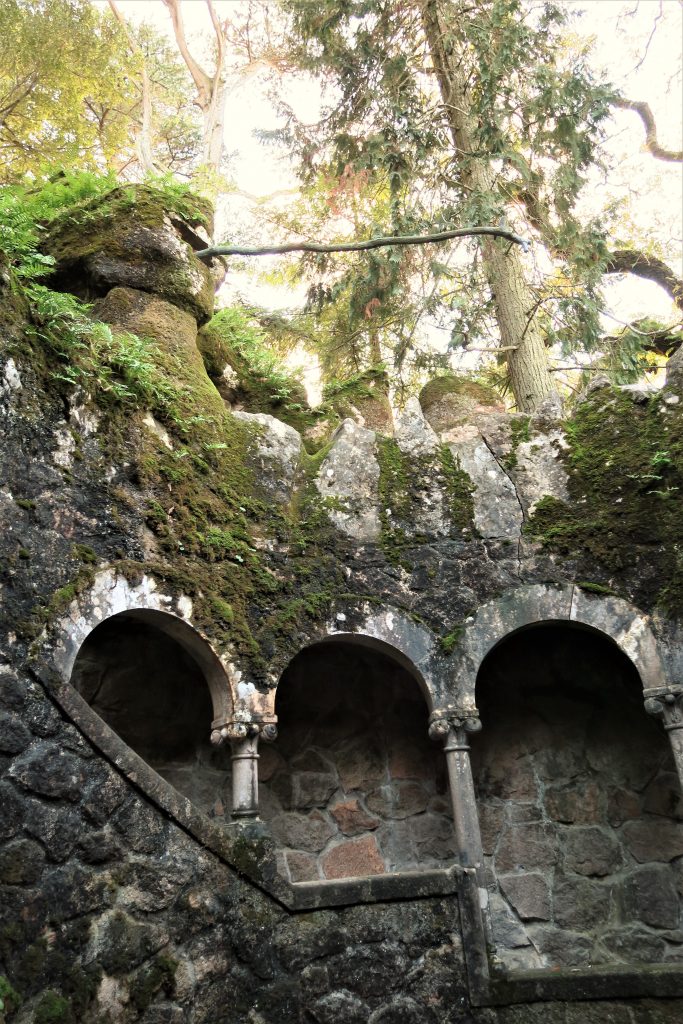
The Initiation Well / Photo by Chris
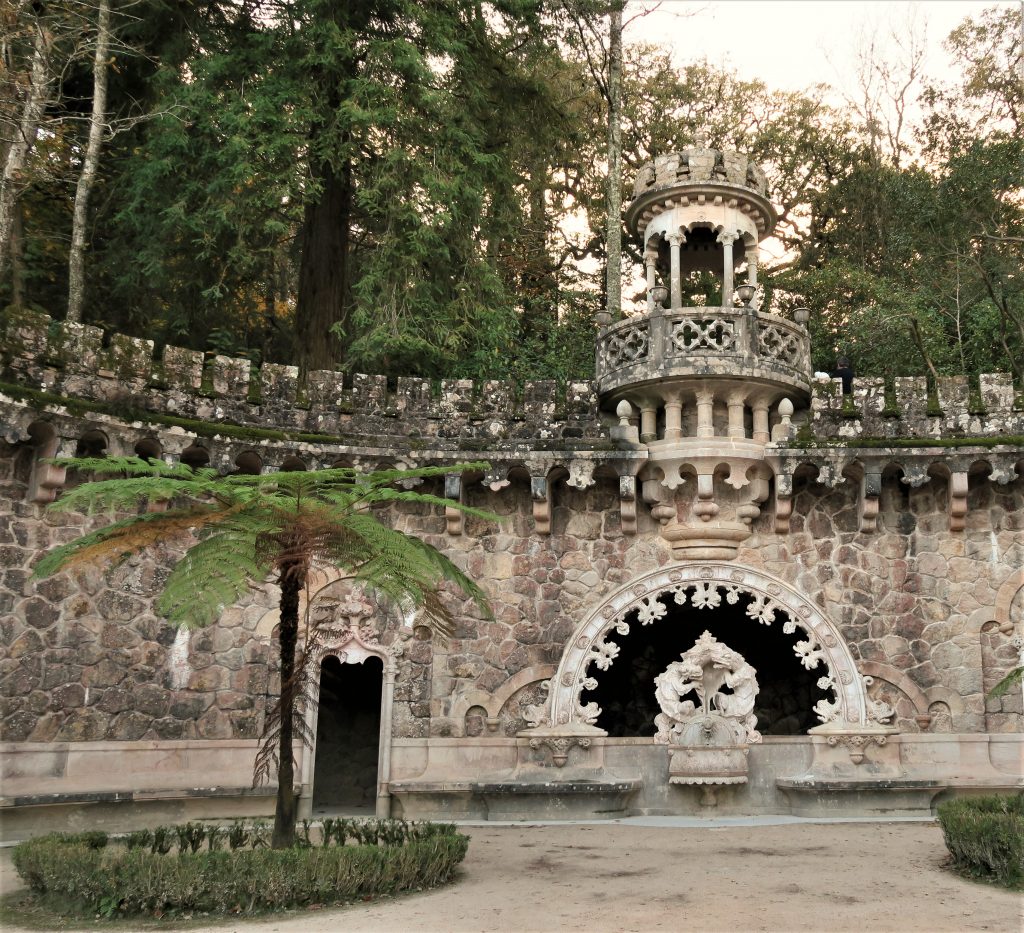
The Portal of the Guardians–crocodiles or dragons? / Photo by Chris
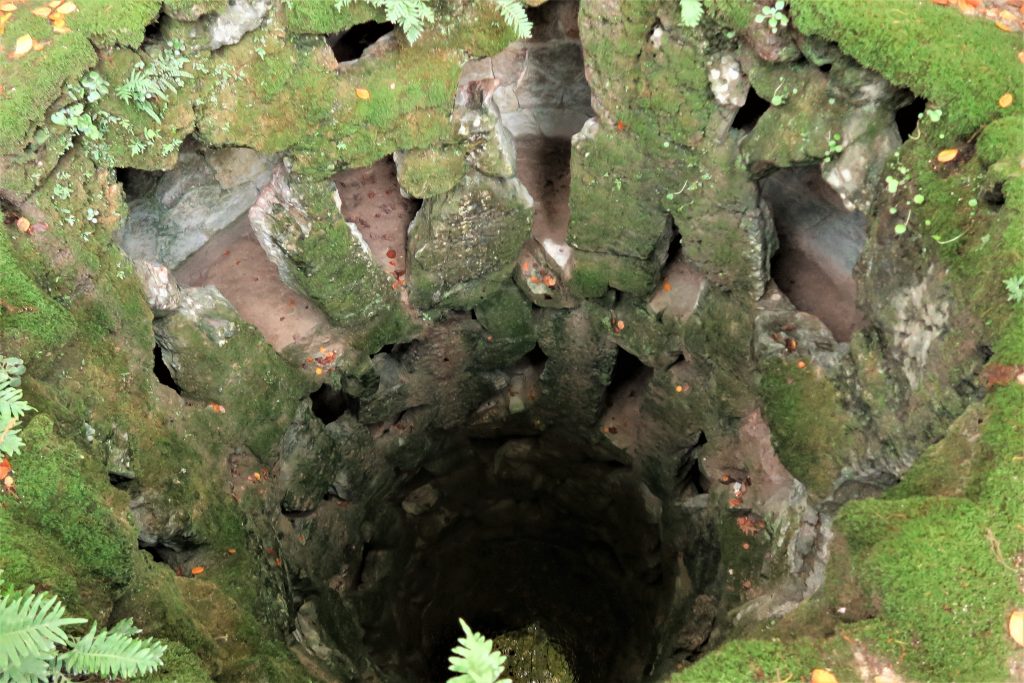
The Unfinished Well / Photo by Chris
Episode Script for Quinta da Regaleira Symbolism: The Occult Mysteries of a Portuguese Palace and Garden
DISCLAIMER: I’m providing this version of the script for accessibility purposes. It hasn’t been proofread, so please excuse typos. There are also some things that may differ between the final episode and this draft script. Please treat the episode audio as the final product.
“Since the beginning of recorded time, Sintra has been regarded as a land cloaked in mysticism. It permeates its steep hillsides and even its air. It’s common to be surrounded in nevoeiro (fog) one moment and the next, bathed in sunlight. . . . You can feel a bigger, stranger power at work in those hills. Its legends have been passed orally through generations and have survived since the time of the Moors — and maybe even before then.”
-from an article in Atlas Lisboa about paranormal events in Sintra, Portugal
“Since the beginning of recorded time, Sintra has been regarded as a land cloaked in mysticism. . . . You can feel a bigger, stranger power at work in those hills. Its legends have been passed orally through generations and have survived since the time of the Moors — and maybe even before then.”
-from an article in Atlas Lisboa about paranormal events in Sintra, Portugal
Intro to topic:
- I visited it by chance, while on my honeymoon in Portugal. My wife and I were headed to a castle higher up on the mountain and got tired right as we reached an ornate portal set against the side of what looked like a large, walled garden set into the side of a mountain.
The whole story:
- About an hour’s train ride from Lisbon lies the town of Sintra. It’s a popular tourist destination, because it’s a charming, historic town complete with several palaces and castles set on the side of a group of mountains.
- Even in the 19th century, it was a favorite haunt of Romantic poets like Byron. Apparently he once wrote a poem that alluded to hooking up with men in Sintra.
- And there’s even a story about occultist Aleister Crowley visiting the area, which we’ll talk about on a later episode, because it’s fascinating and weird.
- And part of the Roman Polanski movie The Ninth Gate, a thriller starring Johnny Depp who plays a rare books dealer, was filmed there. (Have you seen that?)
- The area has a pretty creepy history.
- In Roman times, the people of the area built a temple to Emperor Octavius Augustus II, but once they built it, Rome rejected it for some reason. So then the people of the area dedicated it to the moon, Cinthia [note: I think pronounced with the th], giving the area it’s name, Sintra.
- One night, in October 1984, the residents of a farm in Sintra called the police, saying that rocks were being thrown at people.
- When the police came, they brought lights and saw that the stones were coming out of thin air.
- When they felt the stones, they were warm to the touch.
- One firefighter said loudly that he didn’t believe in witchcraft, and then a stone came flying at him and would have smashed his head if he hadn’t stepped back at the last minute.
- The activity seemed centered around the groundskeeper, but no one knew why, and after that night, it didn’t happen again.
On the side of a mountain in Sintra, Portugal, sits a strange, esoteric estate.
- The buildings are full of symbolism related to Freemasonry, the Knights Templar, the Rosicrucians, and alchemy. Stylistically, the buildings are a combo of Roman, Gothic, Renaissance, and Manueline.
- The Manueline style is a Portuguese architectural style that looks like if a Gothic church, a wedding cake, and an Indian palace were combined into an extravaganza of carved flowers, birds, and nautical elements.
The first named owner I could find of the property was the Baroness da Regaliera.- She was the daughter of a wealthy merchant from Porto, the big port city in Portugal.
- She bought the land in 1840 and turned it into a summer home, complete with a huge house and a chapel.
- In 1892, an eccentric millionaire entomologist named António Augusto Carvalho Monteiro bought the estate at a public auction.
- He was born in Rio, but his parents were Portuguese.
- His family was wealthy, and he became even richer by selling coffee and precious stones in Brazil. When he moved to Portugal, he studied law.
- The official guide to the estate calls him a “celebrated capitalist,” which seems about right.
- Apparently he was a bibliophile, collector, poet, and an occultist.
- One of the few concrete details I was able to find about him was that he was famous for owning what was at the time the most complicated watch in the world, called a Leroy 01.
- After buying the estate, Monteiro purchased some other land around it. The official map says that the property is pentagonal, though other people have noted that it looks like an upside down pentagram.
- Monteiro was originally going to build a French Neo-Gothic house on the property, but by chance while on a train ride, he met an Italian architect and opera set designer named Luigi Manini. They must have really hit it off, because he hired Manini to help design the estate, which they built over the course of 6 years, from 1904 to 1910.
- The estate sprawls across 10 acres of land. It contains various grottos and ponds, which they had to built 5 miles of acqueducts to bring water to.
- It was known as the “Palace of Monteiro the Millionaire”
- There’s a weird dearth of good information in English about the site; almost everything I found was just a regurgitation of the information from wikipedia.
- There was one book that I found that looked good, but it was in Portugese, is out of print, cost 100 to buy used, and I couldn’t find it online.
- So instead, I read every article I could find about the estate.
- A bunch of the articles about contradict each other.
- For example, I found one article that claimed that Monteiro wasn’t a Freemason, and that the Templar symbolism is just his homage to Portugal’s history, and that no initiation rites were held on the site.
- Based on the level of occult symbolism on the estate, that seems like BS, but I’m mentioning it just as an example of the kind of variation there is in what’s been written about the place.
- Also, based on the youtube videos I watched, a lot of the interest in the site is just because people are able to take good instagram pictures of the Initiation Well, so a lot of articles about it are basically just vehicles for those pictures.
- Most of the stuff I read about the estate basically said, “It’s really weird and beautiful, it’s full of occult symbolism, it’s a mystery and we’ll NEVER KNOW WHAT IT MEANS.”
- But that seems really ridiculous to me, because it’s barely more than 100 years old, and I don’t think any of the occult symbolism is lost to time, or anything.
- When I was there, I was able to recognize a decent amount of the symbolism, just based on what I learned in my classics courses in college and the little bit of occult reading that I’ve done.
- But I felt sure I could find someone who could put a lot of the pieces together, and I did!
- I found the website of a Finnish writer, musician, and filmmaker named Aki Cederberg. He visited the estate and had a lot to say about the occult symbolism, so as I talk about the estate, I’m going to summarize some of his points, especially about areas that were closed when we visited. If you want to read his full piece about it, I’ve linked it in the show notes, along with all of my other sources.
- First, Cederberg claims that the whole estate is an upside down, or inverted pentagram, based on the shape of the borders of the estate, and how everything in the estate is oriented. In the shownotes, I’ve included a link to a map of the grounds, so you can see for yourselves. I sort of see it?
- Cederberg got to see some parts of the palace that were closed when we were there, and pointed out that:
- Monteiro once had a huge esoteric library. It sounds like the books are elsewhere these days, but the library apparently has a black floor with mirrors at the bottoms of the bookshelves, which makes the room look like it’s floating.
- There’s an alchemical motto about internal purification written on the wall. In latin, it’s abbreviated as VITRIOL: Visita Interiora Terrae Rectificando Invenies Ocultum Lapidem (Veram Medicinam). (Sorry about my bad latin. The English is: Visit the Interior of the Earth, and Rectifying (Purifying), you will find the Hidden Stone (True Medicine)
- There’s also a quote from Henrique José de Souza who was an occultist, though I couldn’t find any info about him in English. The quote translates as: “Lead me from illusion to reality, from darkness to light, from death to immortality.”
- The chapel was also closed when we were there–we were able to look in from the doorway, but not go inside. But Cederberg had some really interesting thoughts on that too:
- He notes that the chapel is built to represent the Axis Mundi, which is the cosmic pillar or world tree, because it has three floors (one underground, one on the ground level, and one above the ground.) So they represent the underworld, earth, and heaven.
- To get into the chapel’s lowest level, the crypt, you have to go through a metal gate with a “spiral-horned animal creature along with a prominent pentagram and two sunwheels”
- A sunwheel, by the way, is an equal-armed cross in a circle. It has a lot of pagan connotations and symbolism, and represents things like the four seasons, the cardinal directions, etc.
- I guess there’s also a thing called a sunwheel or sonnenrad, which is a neo-nazi symbol. According to the anti-defamation league, those are usually circular symbols with a bunch of crooked rays going out toward the edge of the wheel.
- The anti-defamation league calls the equal-armed cross with a circle a celtic cross, sun cross, or Odin’s cross, and apparently it’s one of the most well-known white supremacist symbols. It became popular among Norweigan Nazis in the 1930s and 1940s, and now neo-nazis, the KKK, and even organizations like the white supremacist website stormfront use the symbol. I actually hadn’t realized that until I looked it up, though I knew the iron cross was a nazi symbol. But btw, the celtic cross is definitely used by non-nazis, but that’s the version with the elongated vertical part.
- He notes that the floor’s black-and-white tiles are similar to ones that Freemasons use, and represent dark/light, masculine/feminine, and balance.
- The altar is carved marble slate with black crosses above and below it. Apparently Monteiro was laid out there after he died in 1920.
- Also, if you look at the map, it says that there’s a secret passageway that goes from the crypt to the palace. I don’t think it’s open to the public, but it’s pretty cool.
- Then you go up a spiral staircase and reach the ground floor. On the ceiling above the main entrance is an all-seeing eye set on top of a templar cross (The all-seeing eye has links to Freemasonry, Egyptian and Hindu mythologies. And, sidenote, I saw other eyes in triangles in other churches around Portugal, especially in Porto, so it’s not so unusual.)
- The area around the main entrance is full of other symbology, too, including a mystic rose, and ark, a grail-like chalice, and a Templar cross. A Templar Cross is just a cross with even arms, a symbol that was used by the Knights Templar.
- The main floor of the chapel also has a templar cross, with pentagrams and sunwheels around it.
- On the ground floor’s altar, is an image of Jesus crowning Mary. Mary’s wearing a dark blue cloak, a white head cloth, a red dress, and a gold shroud. All of those colors apparently represent the process of alchemy.
- The outside wall of the chapel has a sculpture of an athanor, or an “alchemical oven”
- I looked it up, and an alchemical oven or furnace was used in alchemical work related to creating a sorcerer’s stone.
- It looks kinda like a tower, with a fire at the bottom.
- It supposedly also symbolised the flame of feelings and great love
- Then, on the upper floor, which you reach by spiral staircase, there’re more Templar crosses and sunwheels.
- Leaving the church:
- Around the estate, there are these large urns or jugs carved from stone, featuring what look like green men (or satyr), surrounded by images of greenery and vines.
- Leda’s cave:
- Do you know the story of Leda and the swan? Basically, Leda was the Queen of Sparta, Zeus wanted to sleep with her, she didn’t want to sleep with him, so he turned himself into a swan and raped her. Some sources, including Cederberg, say it was a seduction, but my understanding was always that it was a rape.
- There’s a ton of classical art depicting this, and it’s pretty creepy/screwed up. I think that it was so popular as an art subject because it was more acceptable to show a lady having sex with a swan than with a man. You can google it.
- So there’s a little cave or grotto with a sculpture depicting the story. When I visited, the cave was closed, but I found a hidden passage that overlooked it, so I saw the sculpture from above.
- I thought it was just another creepy classical reference to the story, but Cederberg said that Monteiro was a monarchist, and this represented his views of divine kingship, and may also have represented the marriage of heaven and earth.
- I think the symbolism there is apt–the leaders of countries often screw over the populace–but if Monteiro really thought that the story of Leda and the Swan represented the good and natural order of things, then that’s not great.
- Above that cave, if you go up some stairs, you end up at the Regaliera Tower, which is one of several towers that you can climb up into and see a view from the top.
- Then, if you keep going up, you’ll see entrances to the cave system, including one that feels really magical and enchanted: there’s a pond called “The Lake of the Waterfall,” which has a series of stepping stones, and if you walk across the stepping stones, you can go behind a waterfall and enter the tunnel system.
- There are also a few other entrances to the system, including The Grotto of the East and the Portal of the Guardians. The Portal of the Guardians is guarded by dragons, or maybe crocodiles, holding a seashell to their ear. Cederberg calls them crocodiles, and says that they’re symbolic because they’re dual water creatures, which appear elsewhere in the estate, as well.
- Cederberg notes that the bottom of the estate is more human (with the house, statues of gods, chapel, etc), while the top is way wilder (with grottos, wells, woods.)
- So this leads up to the main event of the estate, the Well of Initiation.
- Well of Initiation:
- It’s called a well, but it was never used for water.
- It’s really more of an inverted tower, where you can walk up, or descend down, via a spiral staircase set into the walls and framed by arches. It’s 90 feet deep. Cederberg counted the steps: There are 139 steps, and 1+3+9 is 13, which he says is a sacred number that represents death and rebirth, or the end of a an initiatory journey. He also points out that there are 22 empty niches in the walls between the staircase and the open area in the middle, which is a sacred number and which recalls the 22 Major Arcana of the Tarot.
- The floor, at the very bottom, is an 8-point compass rose, made of blue, yellow, red, and white marble.
- If the whole estate is a journey toward initiation, this is where the initiation happens.
- At the very bottom, there’s a baptismal font. After that, now that you’re underground, you’re surrounded by dark passages that lead away from the well.
- We only walked around underground a little, but they’re manmade but look more like caves than tunnels. Apparently they lead to a bunch of different locations around the estate, as well as to dead ends like the unfinished well.
- You can’t go up into the Unfinished Well from below, but you can start to descend from above. It’s 33 feet, about a third as deep as the initiation well.
- I went down from the ground level, and it’s extremely creepy. It’s much darker than the initiation well, and it’s much emptier (I didn’t see anyone else while I was descending.) I only went down a few levels, but it felt like a weird, broken twin of the initiation well. Instead of refined arches and columns, there were rough stone openings that I could look out from. Before long, I went back up.
- He notes that the Yew tree is planted right next to the Initiation well, which is “traditionally associated with both death and immortality” he also notes that “Yew is sacred to Hecate, “lady of the underworld”, who lives in a cave and presides over secret, illuminating rituals. In the Nordic tradition, Yew is sometimes thought of as the World Tree Yggdrasil and is connected to the runes eihwaz and yr.”
- Of the other trees on the estate, he notes: “Cypress, which has similarly deathly associations, stands by the cave entrance to the crypt of the chapel; while at the side of the upper level of the chapel is lofty Oak, standing for majesty, victory, immortality and fruitfulness, sacred in the various pantheons to the high gods Zeus, Jupiter and Thor. In the upper, rockier and wilder regions of the estate we find Pine, marking steadfastness and loyalty, and sacred to Neptune, Dionysus, Diana, and Cybele. As we see by these examples, the nature of the garden is alive with different personalities and powers, and serve a purpose in unfolding the narrative of the journey.”
- One thing that was interesting to me was that even though there were TONS of different types of plants in the gardens, the map calls out several varieties specifically, pointing them out the same way that they might point out a well or grotto. The ones they point out are (starting at the lowest part of the estate, and going up): Cypress, Norfolk Island Pine, Oak, Cedar, Magnolia, Camellia, Tree-Ferns, Chestnut, Lime Tree, Horse Chestnut, Cycad, Pine Tree, Sequoia, Yew, and Cork Oak.
- Here’s some symbolism related to some of those plants:
- Camellia: this flower has a bunch of different meanings. For example, tea is sometimes made from Camellia flowers, so it can be used in Tasseography, which is divination using tea leaves. I guess it also has numerological meanings. It’s the number 11, which symbolizes mystical awareness, and has the numerological number of 2, which I think it taken from adding the 1 and 1 in 11. 2 is lunar and magical, and is tied to spiritual growth.
- Sequoias, or redwoods, are some of the oldest living beings on the planet. They can live up to about 3,200 years, and they’re the world’s largest trees. So they have a lot of spiritual significance, and they’re also associated with the wands suit in tarot.
- The lime tree, also called the Linden tree, is significant in many different mythologies. To list a few: They’re sacred trees in Slavic mythology, in Baltic mythology there’s a goddess of fate name Laima, who lived in a line tree and made her decisions as a cuckoo. So Lithuanian women spoke to lime trees as if they were humans, treated them with a lot of respect, prayed under them, etc. To pre-Christian Germanic peoples, the lime tree was holy, and they had judicial meetings beneath lime trees, believing the tree would help unearth the truth.
- Cycads and Fern Trees are both really old, and appear in the fossil record, so they’re really ancient trees. I read an interesting article that called Cycads the loneliest plant in the world, and which talked about how in the Jurassic period, 20% of the world’s trees were Cycads.
- You’ve probably seen pictures of these–they look kinda like short palm trees, with thick, kinda spiky trunks. They survived what killed the dinosaurs and lived through 5 ice ages, until in 1895, a British botanical garden director saw one in Africa, dug it up, and sent it back to England where it was put in the Royal Botanical Gardens in London. I guess the rest of them in Africa died, because later on, researchers looked for another one, and couldn’t find any others.
- My guess is that British colonizers probably chopped them all down for firewood, or something. The Cycad in London was a male tree and needed a female tree in order to reproduce, but no one’s ever been able to find a female tree. So now there are other Cycads in other gardens, but they’re all clones of this one tree that was found in the 1895. The original is still alive, but no one knows how long it’ll live.
- The reason why I’m telling this long story about trees is that I think there’s symbolic meaning there, in something being the last of its kind, and being shared and copied into other places. It feels to me almost like how knowledge, including occult knowledge, works. If you know something, and you die, then your knowledge dies with you. The only way you can keep that knowledge alive is by spreading it, or seeding it elsewhere, for other people to know. The purpose of this estate is initiation, which is the process of giving people secret knowledge. We can assume that when Monteiro was alive, ritual initiation happened there. But even now, going through the gardens is its own initiation. Whether you’re knowledgeable about the occult and classics, or not, it’s impossible to explore the gardens without a sense of wonder, and without questioning what occult purposes this estate was created for.
- So that’s the estate.
- The same architect, Manini also built Monteiro’s tomb, in Lisbon’s Prazeres Cemetery. The tomb’s door was opened with the same key that unlocked the palace of Quinta da Regaliera, as well as his palace in Lisbon. When you enter the cemetery grove, the tomb’s on the left, facing east, and it matches the placement, shape, and size of a Masonic temple. The door knocker bears an engraved bee carrying a skull. In Masonry, the diligent and hard-working bee represents the Mason. On the back of the tomb, there’s a gate that shows wine and bread (representing spirit and body), owls (symbolizing wisdom) and poppies (which stand for eternal sleep.)
- But what happened to the estate in later years?
- In 1942, the estate was sold to someone named Waldemar d’Orey and used as a private residence for his large family.
- In 1987, it was sold to the Japanese Aoki Corporation, a construction company. It’s really unclear what the Aoki Corporation used the estate for. All I could find was that they purchased it, and it was closed to the public for the ten years that they owned it.
- I was able to find out a bit about the company. They were founded i the 1940s after the war, and expanded a bunch in the 1980s, ending up with major bank debt. During this time, they branched out into the hotel industry, buying the Westin Hotels chain and selling the Plaza Hotel, which Westin owned, to Donald Trump in 1988.
- The company was involved in some shady stuff, including being a member of a a price fixing cartel that was broken up by the Japanese FTC in 1989. As a result, they were banned from getting construction contracts in Osaka. They were also the cause of the second-deadliest construction accident in Hong Kong, when one of their elevators killed 12 workers. The company went bankrupt in 2001, after what sounds like years of decline when the Japanese recession hit
- But why did they buy the estate? Did they want to make it into a hotel? If so, why hold onto it for 10 years and do nothing with it? Was it a place for execs to have wild parties? The whole time while I was there, I couldn’t stop thinking about the whole thing would have been a pretty good playground for a bunch of drunk, rich executives and their clients. It had a little bit of a Bohemian Grove vibe. (Sidenote: do you know what Bohemian Grove is? It’s a private campground owned by a “gentlemen’s club,” and a bunch of super rich and famous men have been members and partied there, including Newt Gingrich, William Randolph Hearst, Herbert Hoover, Henry Kissinger, Jack London, Richard Nixon, Ronald Reagan, Theodore Roosevelt. There’s been a lot of pretty dark allegations about the place, which we won’t get into here. But basically it’s a big park for powerful men to play in, and there’s some occult symbology, like a huge rock that looks like an owl called the Owl Shrine, that they allegedly do rituals in front of. Allegedly.)
- Though I guess we’ll never know what the Aoki Corporation used Quinta da Regaleira for.
- In 1997, the company sold the estate to the Sintra town council, who opened it to the public in June 1998. It’s now one of the most popular tourist destinations in Sintra.
Sources consulted RE: Quinta da Regaleira Symbolism
Websites RE: Quinta da Regaleira Symbolism
- map:
https://www.regaleira.pt/media/1004/folhetoen.pdf - https://www.tripadvisor.com/Attraction_Review-g189164-d484394-Reviews-Quinta_da_Regaleira-Sintra_Sintra_Municipality_Lisbon_District_Central_Portugal.html
- https://en.wikipedia.org/wiki/Ant%C3%B3nio_Augusto_Carvalho_Monteiro
- https://masterhorologer.com/2018/02/15/l-leroy-cie-leroy-01-other-important-historical-watches/
- https://en.wikipedia.org/wiki/Luigi_Manini
- https://portugalvirtual.pt/sintra/quinta-da-regaleira.php
- http://www.sintra-portugal.com/Attractions/Quinta-Regaleirais-Sintra.html
- https://www.findagrave.com/memorial/182187259/ant_nio-augusto-de_carvalho_monteiro
- https://www.regaleira.pt/en/mapa
- https://archive.org/details/AntonioAugustoCarvalhoMonteiro-UmNaturalistaPioneiro/mode/2up
- https://en.wikipedia.org/wiki/Manueline
- https://en.wikipedia.org/wiki/Aoki_Corporation
- https://www.thevintagenews.com/2016/10/06/quinta-da-regaleira-one-of-the-most-visited-residences-in-sintra-portugal/
- http://www.barcroft.tv/portugal-initiation-wells-deep-tourist-attraction-lost-time
- https://en.wikipedia.org/wiki/Bohemian_Grove
- https://en.wikipedia.org/wiki/List_of_Bohemian_Club_members
- https://wiccanrede.org/2019/05/strange-tales-of-aleister-crowley-the-mouth-of-hell-and-the-abbey-of-thelema-part-1/
- https://en.wikipedia.org/wiki/The_Ninth_Gate
- https://www.atlaslisboa.com/sintras-myths-legends-and-paranormal-activity/
- contains a lot of occult symbolism RE: the estate: http://www.akicederberg.com/new-page-1
https://www.atlaslisboa.com/monserrate/ - Byron’s poem: https://www.romanticpoets.org/public_html/p5/poems/lb1812_childe_harold_01_portugal.htm
- https://www.countrylife.co.uk/architecture/quinta-da-regaleira-portugal-mysterious-garden-designed-world-famous-set-designer-architect-173427
- https://en.wikipedia.org/wiki/Leda_and_the_Swan
- https://en.wikipedia.org/wiki/Leda_(mythology)
- https://www.buildingbeautifulsouls.com/symbols-meanings/flower-meanings-symbolism/camellia-meaning-symbolism
- https://www.buildingbeautifulsouls.com/symbols-meanings/tree-symbolism-meanings/oak-tree-meaning-symbolism/
- https://en.wikipedia.org/wiki/Cycad
- https://www.npr.org/sections/krulwich/2011/05/10/136029423/the-loneliest-plant-in-the-world
- https://www.newsgram.com/sequoia-trees-and-spirituality
- https://en.wikipedia.org/wiki/Sequoiadendron_giganteum
- https://www.buildingbeautifulsouls.com/symbols-meanings/tree-symbolism-meanings/sequoia-tree-meaning-symbolism/
- https://en.wikipedia.org/wiki/Lime_tree_in_culture
- https://visitsintra.travel/en/visit/monuments/palace-and-quinta-da-regaleira
- https://en.wikipedia.org/wiki/Laima
- https://pt.wikipedia.org/wiki/Henrique_Jos%C3%A9_de_Souza
- https://www.ancient-symbols.com/symbols-directory/sun-wheel.html
- https://www.adl.org/education/references/hate-symbols/sonnenrad
- https://www.adl.org/education/references/hate-symbols/celtic-cross
- https://www.ancientpages.com/2018/08/20/12-alchemy-symbols-explained/
- https://viajeraymochilero.com/en/la-quinta-de-regaleira-sintra-portugal-2/
- http://www.builtconstructions.in/OnlineMagazine/Bangalore/Pages/Quinta-Da-Regaleira,-Sintra,-Portugal-0076.aspx
- https://www.flickr.com/photos/toyaguerrero/5661984523
- https://surviveportugal.blogspot.com/2014/07/quinta-da-regaleira-sintra.html?m=1
- https://www.ptraveler.com/2014/06/05/mystic-craze-at-quinta-da-regaleira/
- https://wonderfulwanderings.com/palaces-in-sintra//
- http://www.estorilportugal.com/features/quinta-da-regaleira/
- https://allthatsinteresting.com/quinta-da-regaleira
- http://www.wallswithstories.com/uncategorized/a-remarkable-estate-in-portugal-with-a-romantic-palace-chapel-underground-towers.html
- https://www.edenflaherty.com/travel-1/2019/7/8/quinta-da-regaleira
- https://www.spottinghistory.com/view/6098/quinta-da-regaleira/
- https://www.gardendestinations.com/sintras-quinta-da-regaleira-invites-exploration/
- http://www.backpacktourist.com/2012/03/quinta-da-regaleira/
- https://www.castleholic.com/2017/01/quinta-da-regaleira.html?m=1
- https://www.stolenhistory.org/threads/quinta-da-regaleira-palace-grounds-and-initiation-wells-sintra-portugal.2158/
- https://paisajelibre.com/jardines-misterio-quinta-da-regaleira/
- http://different-doors.com/quinta-da-regaleira/
- https://madhouseheaven.com/mysteries-of-quinta-de-regaleira
- https://www.ancient-origins.net/news-ancient-places-europe/masonic-initiation-wells-quinta-da-regaleira-002263
- https://www.travelwithwinny.com/quinta-da-regaleira-sintra/
- https://www.montgomeryadvertiser.com/story/news/local/blogs/2019/02/23/quinta-da-regaleira-travel-portugal-sintra/2962119002/
- https://www.atlaslisboa.com/sintras-myths-legends-and-paranormal-activity/
Listen to the of the Ouija board series:
- Ouija Boards Part 1 – Planchette and Automatic Writing
- Helen Peters and Ouida / Invention (Ouija Boards Part 2)
- William Fuld (Ouija Boards Part 3)
- 19th Century Ouija Board Stories / Early Ouijamania (Ouija Boards Part 4)
- Victorian Egyptomania (Ouija Boards Part 5)
- Ouija after World War I (Ouija Boards Part 6)
- 1920s Ouijamania (Ouija Boards Part 7)
- More 1920s Ouija Board Stories (Ouija Boards Part 8)
- Kill Daddy: The Turley Ouija Board Murder (Ouija Boards Part 9)
Don’t miss our past episodes:
- The Renwick Ruin:
- Playing the Ghost in 19th Century Australia
- Investigating the Hawthorne Hotel:

